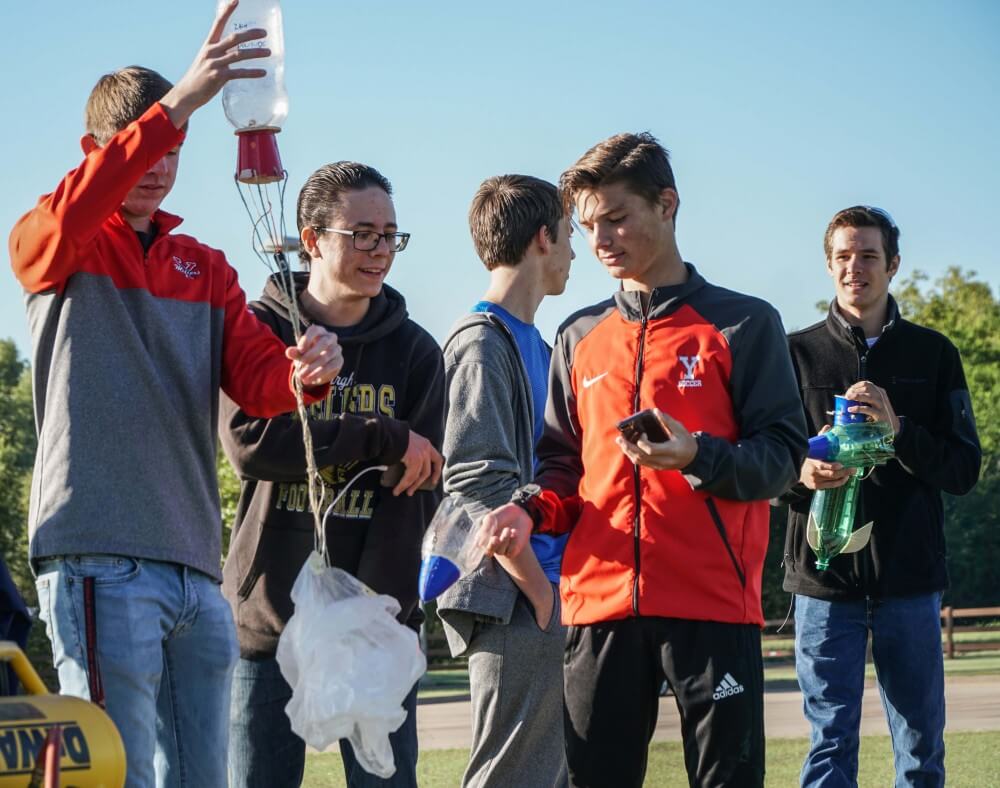YUKON – Blue, cloudless skies made an impressive canopy over central Oklahoma last week as students who are enrolled in Pre-Engineering at Canadian Valley Technology Center’s Dr. Earl Cowan Campus took turns launching homemade water rockets.
“It really is rocket science,” admits Gift Varghese, who was a co-winner in last year’s morning student rocket competition. Rockets are a team project. Varghese was paired this year with fellow Piedmont High School senior Logan Young.
“We changed the design I used last year a little,” Varghese said. “We have larger fins for better stability, and we are using a (two-liter) Dr. Pepper bottle this year instead of a Sprite bottle.”
Students’ rockets reach upwards of 350 feet after launch.
About a half-liter of tap water is poured into each pop bottle fuselage before it is pressurized with 100 pounds per square inch of compressed air. Water, which is roughly 100 times heavier than air, acts as the propellant for the launch.
For the build, each team is provided with identical components, except for the bottle, Varghese said. Bass wood strips are provided for fins, but students must design and cut fins themselves. A small altimeter is provided for each rocket to measure launch height.
Nose cones must be designed by students and are produced on a 3D printer that is provided in the classroom. The cones must separate at maximum height to allow a parachute payload to deploy from a plastic cup that is secured to each rocket.
Students measure the length of time taken for the parachute to reach the ground. Many parachutes took up to 30 seconds to reach the ground. Some never deployed as fell to earth as lawn darts.
As for Varghese and Young, their parachute deployed for 35 seconds before landing softly on grass. But their second launch of the day resulted in no parachute deployment and a hard crash. The two-liter bottle was dented beyond repair.
“Lawn dart,” Young said. “Oh well.”
Two teams’ parachutes reached the one-minute mark before landing. The morning team with the best time consisted of Mustang junior Zach Clark and Yukon senior Bryan Hawk.
Hawk’s father, also Bryan Hawk, is a former Pre-Engineering instructor who now works as Instructional Services Coordinator at CV Tech’s El Reno Campus. He comes back each year to watch the launches. He said Pre-Engineering students started launching paper rockets at the program’s inception in 2007 and moved on to water rockets a couple years later.
Water rockets share many design similarities with NASA’s propulsion rockets with the major exception being NASA rockets use jet fuel instead of compressed air and water.
The rocket project promotes the study of engineering concepts including inertia, gravity, air resistance, acceleration, momentum, freefall calculations, ballistics and more.
Pre-Engineering has evolved to include sophomores. The college-prep curriculum is rooted in Science, Technology, Engineering and Mathematics (STEM) and aims to prepare area students for success in engineering at the collegiate level.


